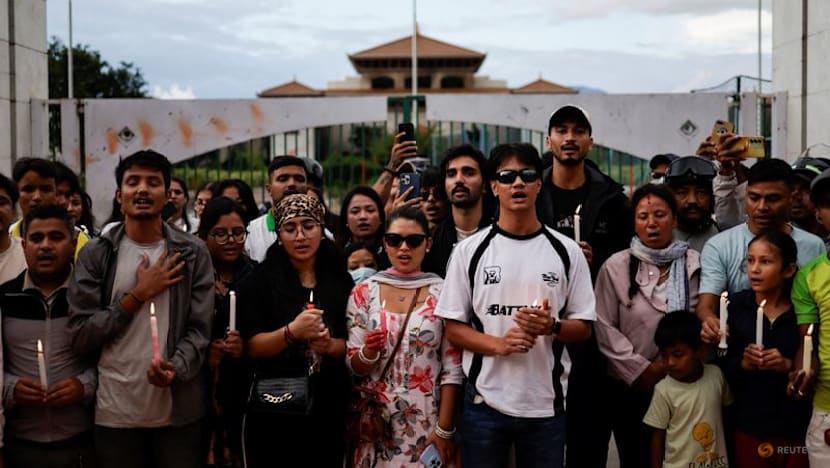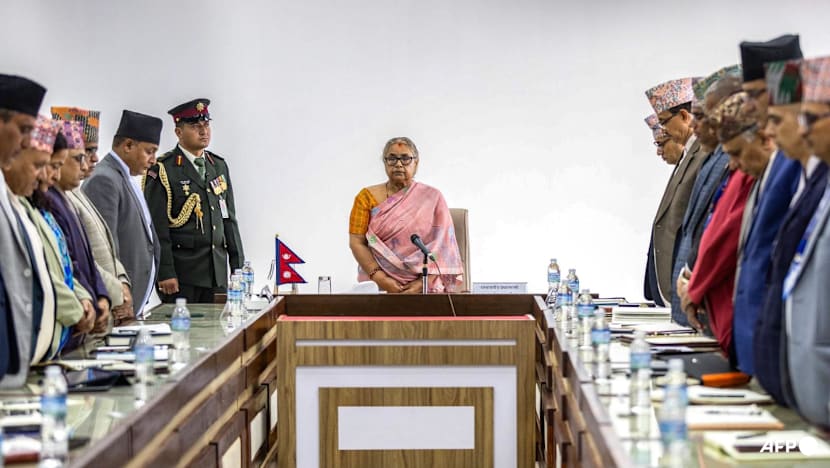Commentary: How Gen Z protests toppled Nepal’s government in 48 hours
Though the Nepali old guard struggled for decades to achieve democracy, they have ignored the frustrations of young people, says Puspa Sharma of the Institute of South Asian Studies.


This audio is generated by an AI tool.
SINGAPORE: The civil uprising that roiled Nepal last week has been termed a Gen Z protest. It was led by youth born between 1997 and 2012, unaffiliated with political parties.
The two-day protests were triggered by a government ban on several social media platforms. But there were deeper problems at play, such as corruption, political instability, nepotism and unemployment.
On Sep 8, peaceful rallies turned violent when protesters attempted to storm the parliament building. Police retaliated with tear gas, water cannons and live ammunition, killing dozens of protesters. This excessive use of force instigated public outrage, leading to more violence and the burning of official buildings and private residences of politicians and business figures. The death toll from the two-day protest has crossed 70.
Certainly, these were not acts of peaceful Gen Z protesters. Evidence is emerging that opportunistic groups leveraged the situation to fulfil their interests.
Nevertheless, the vandalism and the chaos resulted in the resignation of Prime Minister KP Sharma Oli, and the formation of a new government led by a prime minister of the Gen Z protesters’ liking.

DEEP PUBLIC DISSATISFACTION
There has been deep dissatisfaction in Nepal with the conduct of politicians, particularly the top brass who have been at the helm of government for at least two decades.
Their collusion and power grabs resulting in instability, normalisation of patron-client relations, politicisation of every state organ including the judiciary, and high-profile corruption scandals are some factors that agitated the people.
It is unfair to discount the struggles and sacrifices that the older leaders have made over the decades to finally achieve a federal democratic republic system in 2008, ending the 240-year-old monarchy. However, the frustrations of young people have gone ignored by the old guard.
Social media was the medium through which youths would vent their anger about these problems. In the days leading up to the ban and protests, the hashtags #nepokids and #nepobabies showcased the youths’ dissatisfaction with the children of politicians and businessmen allegedly enjoying lives fuelled by corruption.
Social media also inflamed public outrage about privilege and inequality. Unverified stories such as leaders having billions of dollars in investments abroad and money in foreign bank accounts went viral. The Hilton hotel in Kathmandu, which began operations last year, was set on fire because of unsubstantiated claims that a politician’s son invested billions in the hotel.
POLITICAL CHANGE IN 48 HOURS
In the past 75 years, Nepal has witnessed several political movements, largely achieving their objectives of toppling the existing regime within months. This time, Nepal’s political scene was completely transformed in less than 48 hours.
On Sep 12, Nepal appointed its first-ever female prime minister, retired Chief Justice Sushila Karki. Until a few days ago, Ms Karki becoming the prime minister was beyond anyone’s imagination, but she became the youths’ favoured candidate for prime ministership.
Ms Karki is outspoken and bears a clean image. She won the youths’ hearts when she visited hospitals to meet wounded protestors as violence raged on the streets.
The president's appointment of Ms Karki goes beyond the provisions of Nepal's constitution on government formation. This is not unusual given the unprecedented protests and the urgency to reinstate political stability.
The chief mandate of Ms Karki’s government is to conduct free and fair elections in six months, on Mar 5, 2026, and hand over to the new government. It also needs to undertake a thorough investigation of the violence, both the killings and the destruction of public and private properties, and bring the culprits to book.
Besides these, perhaps there is little else that the interim government formed for a short period can deliver. Nevertheless, it needs to set examples and lay the foundations for good governance.
The political parties decried the unconstitutional steps taken in dissolving parliament. However, they have been gradually expressing support for the elections. Nepali youths are not against the existing political system. They want to retain its framework, but want better governance and economic equality.
Party leaders may need to step aside, and parties should consider restructuring before contesting the elections. The status quo will invite more unrest. Further confrontation will not help Nepal rise from the ashes.
Puspa Sharma is Visiting Senior Research Fellow at Institute of South Asian Studies, National University of Singapore.
















